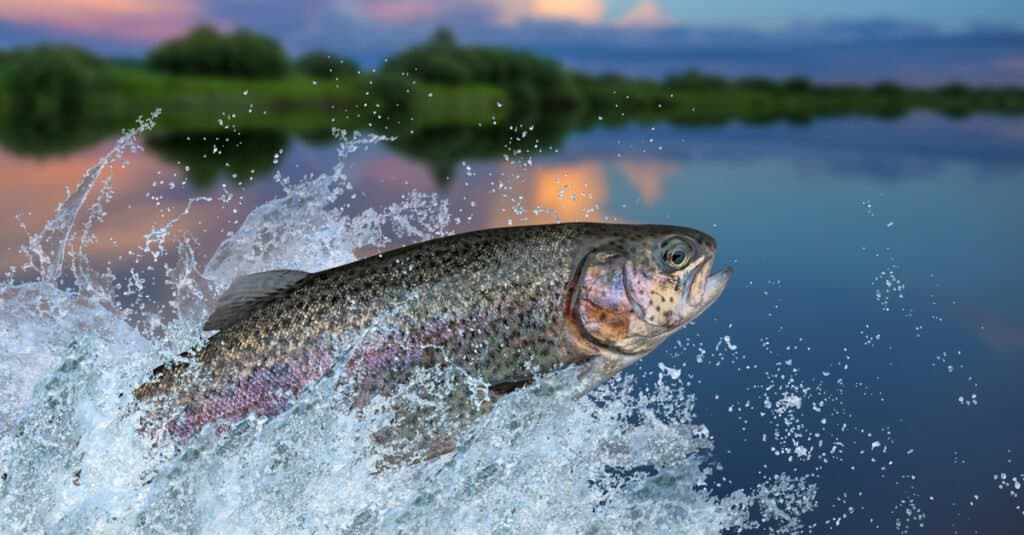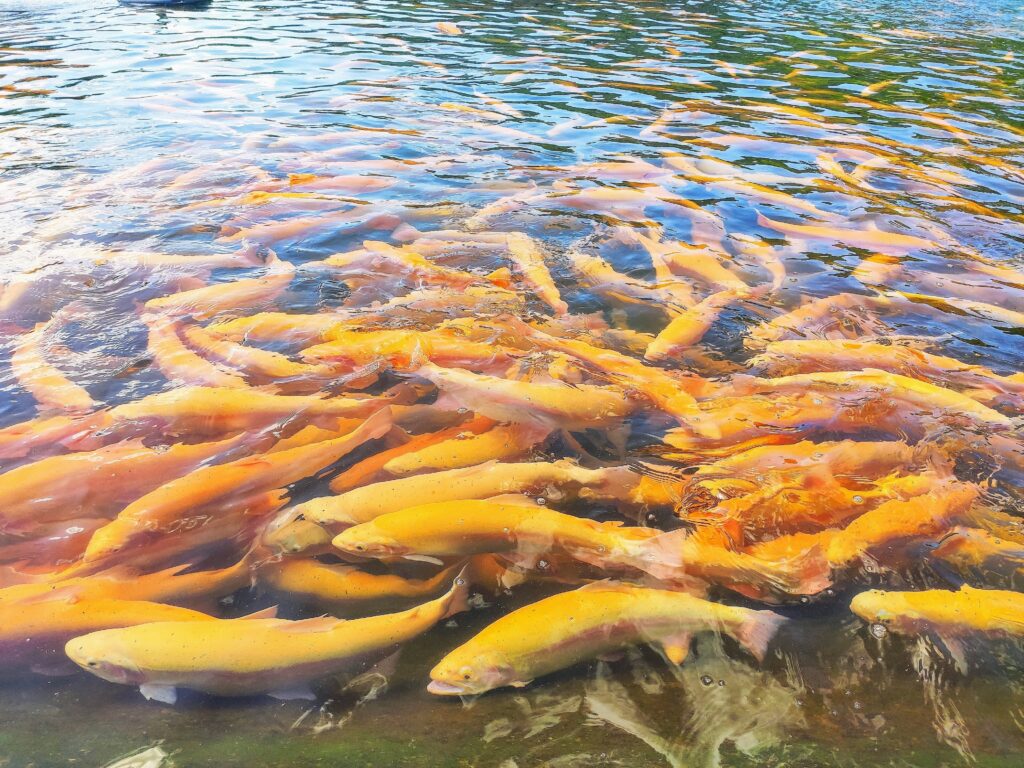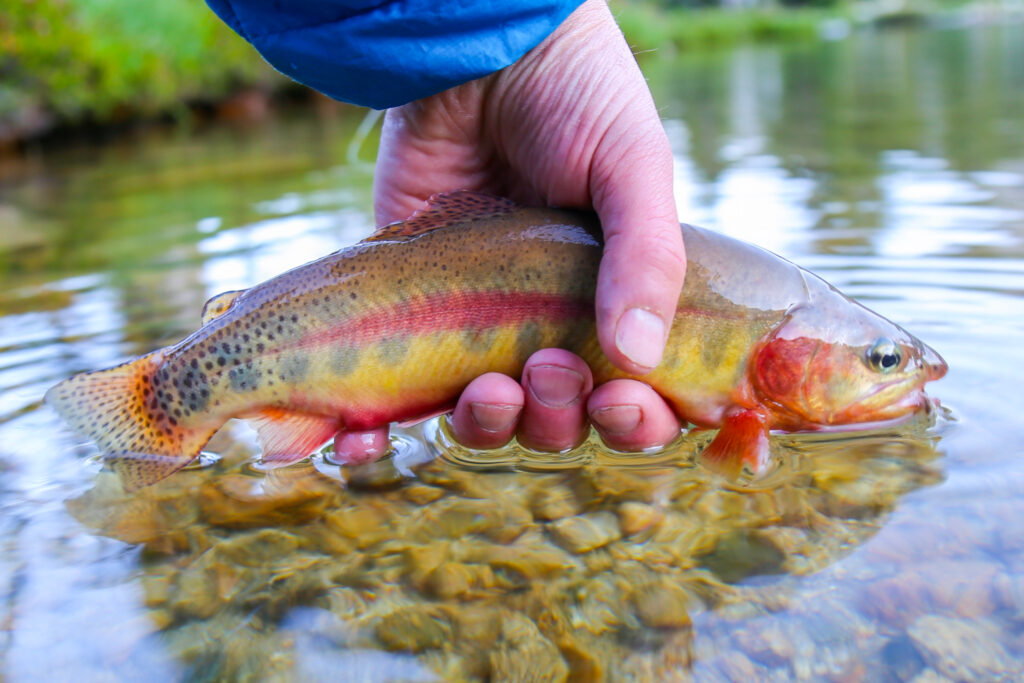Are you a fan of fishing for golden trout? Maybe you haven’t caught your first golden trout yet, but you’ve been a fan of fishing in Idaho for quite some time. Getting a huge golden trout on your hook in any Idaho lake is no easy feat. But, it is certainly possible. In fact, there are quite a few massive golden trout that have been caught across Idaho. But which one was the biggest? What can Idaho anglers hope for?
In this guide, we’ll explore everything you need to know about fishing for golden trout in Idaho. We’ll also take a look at the biggest golden trout ever caught in the Gem State. But first, what exactly are golden trout? What is the history of golden trout fishing like in the great state of Idaho? Let’s take a look!
What are Golden Trout?
Golden trout are a subspecies of rainbow trout that is classified as Oncorhynchus mykiss aguabonita. This popular fish is found in the lakes of Idaho and the Sierra Nevada Mountains of California. However, Idaho populations were introduced years ago, and they are not considered native fish in the Gem State. Because of their distinctive golden color, these strikingly gorgeous fish are highly valued by fishermen. Their color distinguishes them from their more common rainbow trout cousins.
A tiny, pointed head and a slightly forked tail are features of the streamlined body of the golden trout. They normally grow to a maximum length of 12 to 14 inches. This is quite a bit less than that of other rainbow trout subspecies. However, even seasoned fishermen find it difficult to land them because of their incredible agility and speed in the water.
Alpine lakes and streams with chilly, clean water are where you’ll mostly find golden trout. They have adapted to the special circumstances present in these far-off habitats. These fish are renowned for their capacity to flourish in arid, mountainous regions.

Golden trout are a subspecies of rainbow trout (pictured) that are native to specific freshwater regions of California.
©FedBul/Shutterstock.com
The Biology of Golden Trout
Golden trout have an intricate and intriguing biology. These fish have a keen sense of smell, which they employ to find aquatic food. They consume a wide range of food items, such as insects, crustaceans, and small fish, since they are opportunistic feeders.
Additionally, golden trout have a distinct method of reproduction. They usually reproduce in the late spring or early summer. This is when the water temperature is ideal for the development of the eggs. Male golden trout will acquire vivid red or orange coloring on their bellies and fins during the spawning phase. This is utilized to entice females.
A female that has been sufficiently seduced by a sensuous spawning male (say that five times fast) will lay her eggs in a “redd,” or a small nest. The eggs are subsequently fertilized by the male. In just a few weeks, they develop into tiny, translucent larvae. These larvae, often referred to as “alevins,” are extremely weak and need the redd’s protection. They will stay there until they are strong enough to swim and survive on their own.
Golden trout only live in the wild for around four to six years on average. But during the first year of life, they are known to develop quickly. This is crucial for their survival in the hostile alpine environment.
Threats to the Golden Trout Population
The natural populations of golden trout are under serious threat, despite their flexibility and toughness. These lovely fish are in decline due to overfishing, habitat degradation, and climate change. Several conservation groups are striving to conserve and restore the habitat of the golden trout. This is being done to guarantee that these fish survive and prosper for many generations to come.
The golden trout is a distinct and unusual subspecies of rainbow trout. It can be found throughout many lakes in Idaho where these non-native fish have been introduced. These fish are highly sought-after catches among fishermen because of their striking golden color and quick swimming skills. They nonetheless play a significant role in alpine ecology. Unfortunately, a variety of environmental conditions pose a threat to their existence. Humans can contribute to ensuring that these stunning fish continue to flourish in the wild. We can do this by learning about the biology of golden trout and acting to safeguard their habitat.
Typical Size of Golden Trout
Golden trout typically weigh between 0.5 to two pounds, making them smaller than other rainbow trout subspecies. Larger specimens have been known to weigh over five pounds, though. The average length of a golden trout is six to 12 inches, with the largest specimens growing to 14 inches.
Despite their diminutive size, golden trout are known for their amazing power and agility in the water. This makes them a difficult catch for even seasoned fishermen. They can readily navigate the rapid currents of alpine streams and lakes. This is because of their tiny size and streamlined body form.
The vibrant and distinctive color of golden trout distinguishes them from other subspecies of rainbow trout in addition to their overall small-ish size. These fish have beautiful, golden-yellow scales down their flanks, and their bellies and fins have a pink or orange hue. In their alpine environment, where the golden color helps them blend in with the sandy bottoms of the streams and lakes they frequent, it is believed that this remarkable coloration originated as a type of camouflage.
Overall, even though golden trout are not the biggest fish in the water, fishermen admire them for their beauty and quickness. Because of their distinctive biology and capacity to survive in challenging mountain habitats, they are an essential component of the alpine ecosystem.
The Largest Golden Trout Ever Caught in Idaho
According to Idaho Fish and Game, there are a ton of massive fish that have been caught in the state, from golden trout to bluegills to bullhead catfish. Currently, the largest golden trout ever caught in Idaho was a hefty 5.13 pounds. Its length and girth were not recorded, but the specimen was caught in Idaho’s White Sands Lake by fisherman George Wolverton.

While the golden trout (pictured) that was captured by George Wolverton was not measured, it was likely quite long and wide to accommodate 5.13 pounds of fish.
©Aleksandra_Chukcha/Shutterstock.com
The Largest Golden Trout Ever Caught in the World
The world’s largest golden trout was a record-breaking catch made in 1948 in the Californian Sierra Nevada Mountains. The fish was a genuinely amazing capture that is still unequaled to this day. It weighed in at an astounding 11 pounds and measured 28 inches in length.
Fisherman Charles S. Reed caught the record-breaking golden trout while fishing at Golden Trout Creek, a secluded and inhospitable region of the Sierra Nevada. Reed allegedly used a hand-tied fly to lure the enormous fish. The specimen apparently put up a valiant battle before being ultimately dragged to shore.
The International Game Fish Association (also known as the IGFA) keeps track of fishing accomplishments from all around the world. The IGFA verified Reed’s capture as the largest golden trout ever caught by a single person. Anglers still talk about the fish as a famous capture that proves the size and power of these elusive species.
There have been many more amazing captures of these fish throughout the years, yet Charles S. Reed’s world-record-breaking golden trout is still the biggest specimen ever recorded. In their native environment, golden trout may reach astonishing lengths and weights. Many have been recorded to weigh over seven pounds and measure more than 20 inches.
Golden trout are a very fun species of fish to catch. The excitement of the capture and the chance to interact with these intriguing species continue to be strong draws for fishermen all around the world. This is so even if landing a fish as enormous as the record-breaking golden trout taken by Charles S. Reed may be a once-in-a-lifetime accomplishment.
The History of Fishing for Golden Trout
Since these fish were originally found in the Californian Sierra Nevada Mountains in the early 1900s, golden trout fishing has had a long and illustrious history. Since then, fishermen have come to admire golden trout for their striking color, outstanding agility, and demanding temperament, making them a highly sought-after species.
There are several reasons why fishing for golden trout has become so popular. For starters, these fish are a rare and special catch since they are only found naturally in the high-altitude streams and lakes of the Sierra Nevada, plus areas of Idaho where they have been introduced as non-native species. Just as well, they are intriguing and lovely fish to view because of their vivid golden hue and distinctive biology.
However, the difficulty of catching golden trout may be the major draw for anglers. Even for seasoned fishermen, these fish are notorious for their amazing speed and agility in the water, making them challenging to capture. The fact that they may also be found in inhospitable, rocky mountain habitats raises the thrill and excitement level of fishing to a whole new level.
The majority of times that golden trout are captured, they are put back into the water as part of sport fishing. This guarantees that fish populations are stable and that they may continue to flourish in their natural habitat and in areas of Idaho where they have been introduced. The meat of golden trout is thought to be of good quality and flavor, thus some fishermen will preserve them as food.
How Fishers Used Golden Trout Through American History
Throughout history, golden trout have also been utilized for a wide range of other things. The California Fish and Game Commission started stocking golden trout in lakes and streams around the state in the early 1900s in an effort to expand recreational fishing options. Golden trout are still supplied in some regions today to support the maintenance of robust fish populations, including in Idaho.
Golden trout have been employed for scientific study in addition to recreational fishing and stocking. Researchers interested in the impact of climate change and other environmental variables on fish populations are interested in golden trout because of the species’ distinctive biology and adaptations to high-altitude habitats.
Golden trout populations are under serious threat in the wild, despite their attractiveness and cultural importance. Numerous conservation organizations are attempting to safeguard and restore this gorgeous fish’s environment as a result of habitat loss, pollution, and climate change. As mentioned earlier, the best thing a golden trout angler can do is put their catch back in the water to improve their populations.
All things considered, the history of golden trout fishing and angling is proof of the fish’s continuing allure. Golden trout provide fishermen with a distinctive and difficult fishing experience that has captured their attention for more than a century, from their uncommon and limited habitat to their outstanding speed and agility in the water. Although their numbers may be in danger, conservation groups’ ongoing work and ethical angler behavior may help guarantee that these magnificent fish continue to flourish for many years to come.

You can find golden trout (pictured) at elevations up to 10,000 feet above sea level.
©CSNafzger/Shutterstock.com
The History of Fishing for Golden Trout in Idaho
Since these species were initially brought to the state’s high-altitude lakes and streams in the early 1900s, golden trout fishing in Idaho has a long history. Since 1924, when the first golden trout were introduced to Idaho and stocked in the Clearwater drainage, they have grown in popularity as a highly sought-after catch among fishermen.
The Alpine Lake Wilderness Area, which spans over 100,000 acres of rocky mountain terrain in the Sawtooth National Forest, is one of Idaho’s most famous spots for golden trout fishing. This region is a favorite among fishermen wishing to test their prowess against these difficult species because it is home to several stocked alpine lakes and streams with golden trout.
There are several more places in Idaho where golden trout can be found. This is in addition to the Alpine Lake Wilderness Area. These include the Sawtooth Wilderness’ streams, the Salmon River’s headwaters, and the high-altitude lakes of the Boise National Forest.
Where is Idaho Located on a Map?
Idaho, located in the northwestern region of the United States, is renowned for its majestic mountain landscapes and expansive protected wilderness areas that offer abundant opportunities for outdoor recreation. The state’s capital, Boise, rests amidst the scenic Rocky Mountain foothills and is divided by the Boise River, which is a favorite destination for thrilling rafting adventures and fishing excursions.
Here is Idaho on a map:
The Challenges of Golden Trout in Idaho
As previously noted in this guide, golden trout populations in Idaho have experienced serious challenges throughout the years. This is despite their popularity among fishermen. Numerous conservation organizations are striving to conserve and restore these fish species’ habitats. This is being done because habitat degradation, pollution, and overfishing have all contributed to population decreases.
The Idaho Golden Trout Recovery Program, which was started in 1996, is one noteworthy endeavor to safeguard golden trout in Idaho. Through population assessments, habitat restoration, and the stocking of certain lakes and streams with golden trout, this program aims to restore and sustain healthy populations of golden trout in the state of Idaho.
Overall, the history of fishing for golden trout in Idaho is proof of the allure of these magnificent fish. Golden trout have played a significant role in the development of Idaho’s fishing culture and ecology. They were introduced to the state’s high-altitude waterways in the early 1900s and are still being actively protected and restored today. Even though these fish have difficulties in the wild, conservation groups’ ongoing work and conscientious anglers’ actions can assist to guarantee the golden trout’s survival in Idaho for future generations.
Golden trout are beautiful fish that are meant to be revered, not overfished! If you get a chance to fish for these incredible creatures in Idago, remember to take your photo and put the trout back in the water. Fish conservation is up to us!
The photo featured at the top of this post is © Sean Lema/Shutterstock.com
Thank you for reading! Have some feedback for us? Contact the AZ Animals editorial team.







